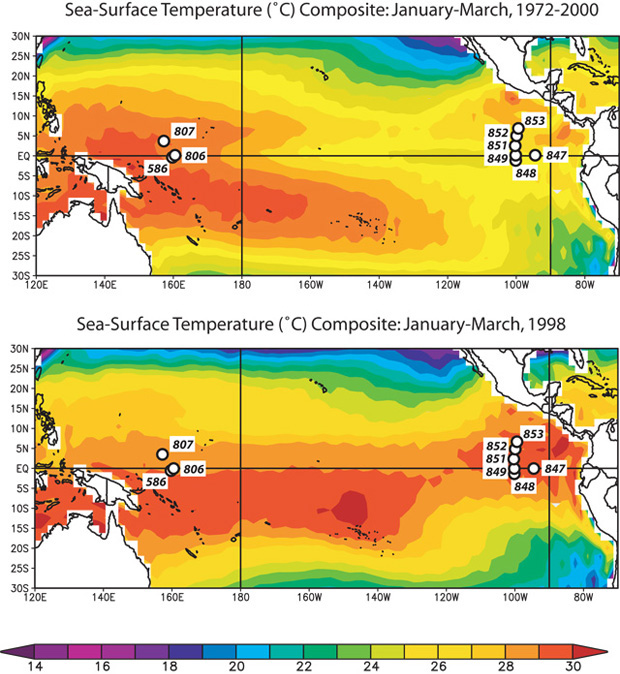 |

|
| Molnar Home | Research Projects | Publications |
| RESEARCH GROUPS @ CIRES > |
Pliocene El NiñoClosing of the Indonesian Seaway and El Niño teleconnections and tropical anomalies as a blueprint for pre-Ice Age climatesSupported solely through patient encouragement from family and friends Collaborators (recent past and present)
Work of Bill Chaisson, Christina Ravelo, Kira Lawrence, Tim Herbert, and their collaborators has shown that before continental ice sheets formed in Canada and Fennoscandia, sea-surface temperatures in the Pacific showed little east- west variability, as they do during El Niño events (Fig. 1). In addition differences between pre-Ice Age and present-day climates in a number of regions resemble those El Niño teleconnections, as we might expect if the atmosphere responded to a permanent El Niño state [Molnar and Cane, 2002]. Further analysis (extends this synthesis to suggest that the El Niño of 1997-98 represents the pre-Ice Age equatorial Pacific sea-surface temperature distribution better than that of other El Niño events [Molnar and Cane, 2007]. As much of Canada warms, at least in winter, during El Niño events, we have explored the possibility that a permanently warm eastern equatorial Pacific would, via its teleconnections to Canada, prevent ice sheets from growing there. As El Niño writes its signature largely in winter, but summer climate dictates whether winter snow survives and can accumulate into an ice sheet, Huybers and Molnar [2007] examined the correlation of El Niño occurrence with positive- degree-days in Canada and found that indeed summers during El Niño events tended last longer and offer greater capability of melting winter snow. When scaled to eastern equatorial Pacific sea-surface temperatures over the past 4 million years, the predicted greater number of positive-degree-days than today should have sufficed to prevent ice sheets from growing. The apparent permanent El Niño state in pre-Ice Age times poses the question of what geologic process destroyed that state. We are pursuing two variants on the theme that the closing of the Indonesian Seaway and the conversion of a largely maritime region into the Maritime Continent both blocked warm water to help form the warm pool in the western equatorial pacific [Cane and Molnar, 2001] and increased precipitation over the expanding Maritime Continent that strengthened the Walker Circulation, whose easterly winds along the equator sustain the warm pool [Dayem et al., 2007]. For the former, Jochum et al. [2009] exploited a coupled ocean-atmosphere general circulation model, and found that although the closing of the Indonesian Seaway should affect tropical Pacific sea-surface temperatures, the calculated change is too small to be important. We have not abandoned the possibility that a closing of that seaway was important, but its effect does not seem to be as simple as we had thought. Finally, Molnar [2008] synthesized evidence that the closing of the Central American Seaway in late Cenozoic time altered ocean circulation and led to a state in which ice ages were possible. He concluded that although one could refute that suggestions, the evidence for it shares much with a house of cards.
ReferencesHuybers, P; Molnar, P (2007), Tropical cooling and the onset of North American glaciation. Clim. Past., 3 (3) 549-557 Molnar, P (2008), Closing of the Central American Seaway and the ice age: A critical review. Paleoceanography, 23 (1) , Art. No. PA2201, doi: 10.1029/2007PA001574 Molnar, P; Cane, MA (2007), Early pliocene (pre-Ice Age) El Nino-like global climate: Which El Nino?. Geosphere, 3 (5) 337-365, doi: 10.1130/GES00103.1 |
